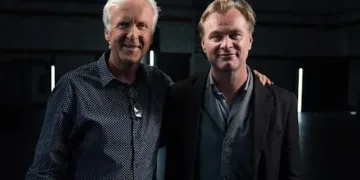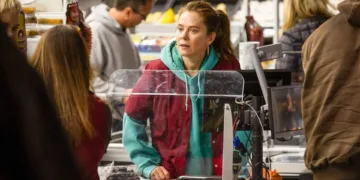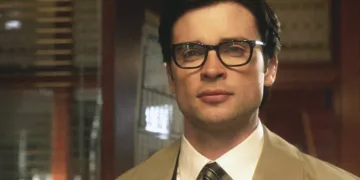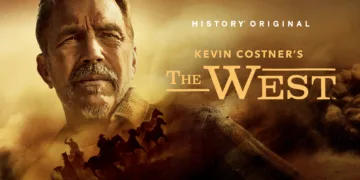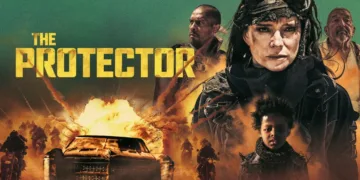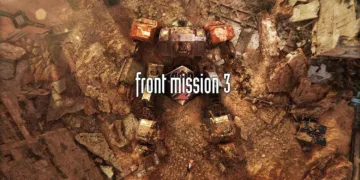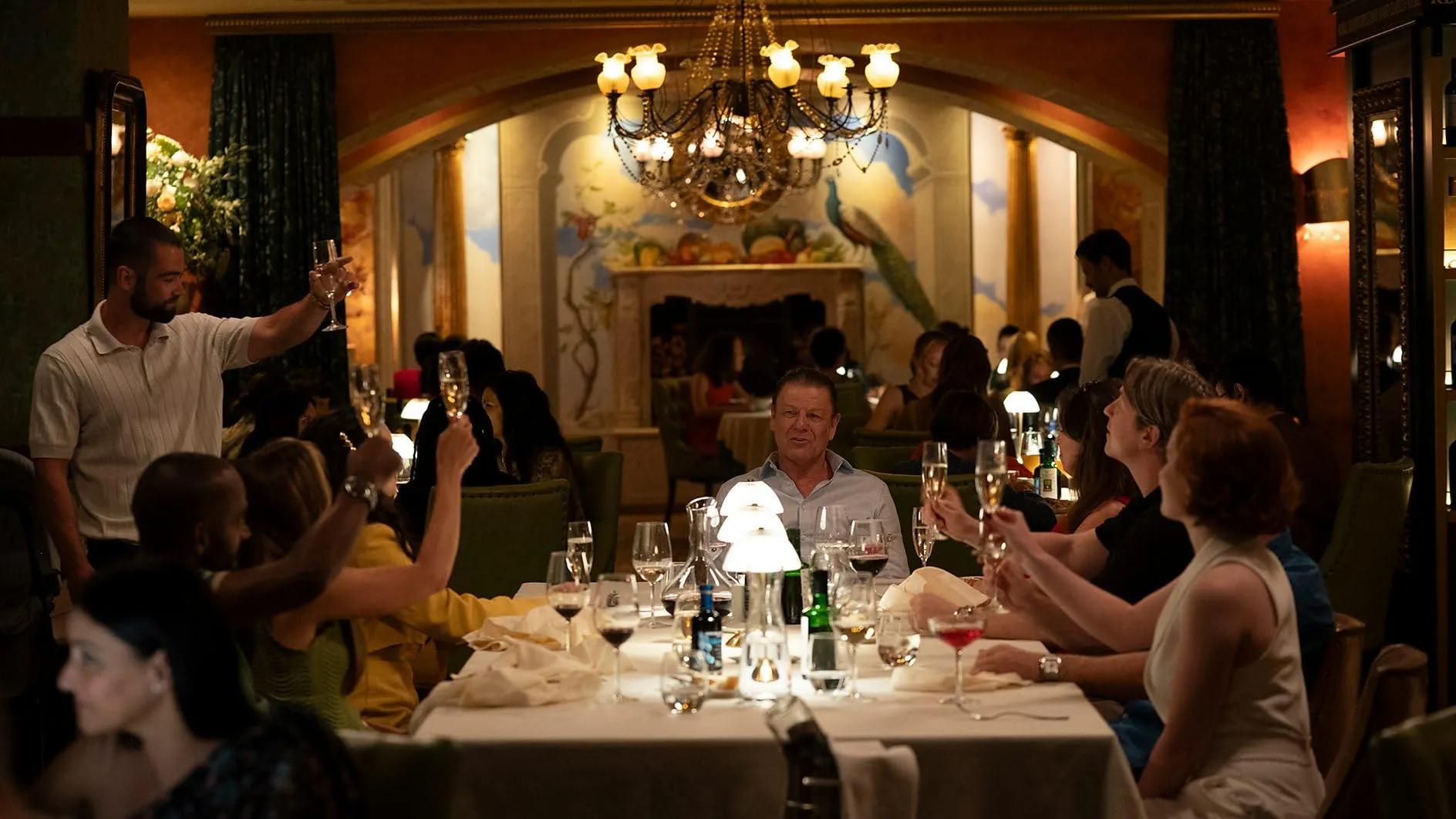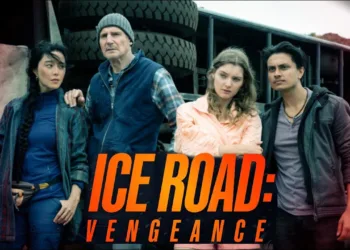This City Is Ours emerges as a gritty, noir-tinged exploration of Liverpool’s underworld, centered on the Phelan crime family. Set in a world of shifting loyalties, familial rivalries, and tense power struggles, the series is both a crime thriller and a family drama, offering a compelling narrative that stretches beyond traditional gangster tropes.
At the heart of the series is Ronnie Phelan (Sean Bean), a seasoned drug kingpin looking to pass on control of his empire. His potential successor is Michael Kavanagh (James Nelson-Joyce), the loyal right-hand man with aspirations of a quieter life with his girlfriend, Diana (Hannah Onslow). Meanwhile, Ronnie’s impulsive son, Jamie (Jack McMullen), challenges his father’s wishes, driving a wedge between family ties and ambition.
The series unfurls a dynamic portrait of power, loyalty, and moral compromise within the murky landscape of organized crime. It’s a tense, slow-burn drama where personal stakes intertwine with violent clashes over control. What This City Is Ours does well is not simply presenting its underworld characters as mindless criminals, but as complex figures embroiled in an evolving narrative of self-interest and fragility—men and women shaped by, yet pushing against, the socio-cultural forces around them.
The Shifting Tides of Power: This City Is Ours and Its Exploration of Loyalty, Betrayal, and Ambition
At the heart of This City Is Ours lies a familiar yet ever-compelling crime drama narrative: the battle for power within a criminal family. Ronnie Phelan (Sean Bean), the aging patriarch, is ready to step down from his reign over Liverpool’s drug empire, yet his decision to pass the torch not to his son, Jamie (Jack McMullen), but to his trusted right-hand man, Michael (James Nelson-Joyce), ignites a devastating conflict. This central tension forms the spine of the series, with loyalty, betrayal, and ego playing out against a backdrop of escalating violence and family dysfunction.
What This City Is Ours does well is weave Michael’s personal life into the criminal narrative. His desire to escape the chaotic underworld for a quieter life with his girlfriend, Diana (Hannah Onslow), is a tender counterpoint to the ruthless violence and ambition that define the Phelan family’s world.
This thematic duality—Michael’s yearning for normalcy versus his entanglement in the family business—injects a fresh complexity into the story, allowing viewers to see the cost of a life built on crime. His struggle to reconcile his love for Diana with his loyalty to the criminal empire creates a compelling inner conflict, driving much of his character development.
However, it is the missing drug shipment that truly unravels the family dynamics. What initially seems like a simple logistical problem snowballs into a full-fledged crisis, exposing deep-seated mistrust, fractured alliances, and the lengths to which each character will go to secure their own future. The slow-burning tension that permeates the first few episodes eventually culminates in a series of violent confrontations, driving the plot into darker, more dangerous territory.
The pacing of This City Is Ours reflects this gradual tension, allowing moments of intimacy to simmer before giving way to brutal outbursts. The pacing may feel deliberately sluggish at times, but it serves the greater narrative of building tension, offering a measured, almost operatic approach to storytelling that heightens the impact of the series’ darker turns.
Key plot moments, such as the escalating rivalry between Michael and Jamie, and the strategic betrayals that permeate every interaction, ensure the series doesn’t simply exist as a predictable crime drama. Each character’s choices ripple through the narrative, and the show’s slow-burn pacing feels like a reflection of the insidious way in which corruption and moral compromise settle into every crevice of the Phelan family’s existence.
The Complex Tapestry of Crime and Family: This City Is Ours and Its Dynamic Cast
This City Is Ours succeeds not just because of its taut, suspenseful plot, but also because of its nuanced portrayal of characters who are as morally ambiguous as they are compelling. At the center of this web is Ronnie Phelan, played by Sean Bean. Known for his complex portrayals of gritty, battle-worn figures, Bean’s portrayal of the veteran crime boss strikes a delicate balance between ruthless authority and moments of vulnerability.
Ronnie is a man who commands power, yet his decisions—especially in relation to his family—speak to a deeper internal struggle. As the series progresses, it’s clear that his attempts to hand over control of the drug empire to Michael rather than his son are not just business decisions, but reflect a deeper, unspoken rift in their familial bond. Bean masterfully layers Ronnie with a sense of tired authority, underscored by the quiet recognition that his empire—and his family—are slipping out of his grasp.
In contrast, Michael Kavanagh, portrayed by James Nelson-Joyce, presents a strikingly different kind of power. Michael’s internal conflict lies not in a need for dominance, but in the desire to leave behind the criminal world and lead a more peaceful life with his girlfriend, Diana (Hannah Onslow).
Nelson-Joyce plays Michael with an understated intensity, capturing the pull between his loyalty to Ronnie and the yearning for a future untainted by crime. His chemistry with Onslow is palpable, their dynamic providing a tender counterpoint to the violent world around them.
Diana, for her part, is caught between these two worlds, representing the personal toll that such a lifestyle takes. Onslow brings depth to the role, portraying Diana as a woman trapped in a cycle of longing for normality while being drawn into the gravitational pull of her partner’s world.
Jack McMullen’s portrayal of Jamie, Ronnie’s impulsive son, injects a necessary volatility into the show. Jamie’s raw ambition and impatience drive much of the series’ tension. His desire to usurp his father and claim the family business sets him on a collision course with Michael, and McMullen captures the chaos of Jamie’s unrefined ambition. Where Michael is composed and introspective, Jamie is reactive and driven by ego, creating a natural friction that propels the narrative forward.
The supporting cast adds further layers to the story. Julie Graham’s portrayal of Elaine, Ronnie’s wife, is one of the more compelling aspects of the series. Elaine exists in a world where complicity and victimhood often go hand in hand. She is not simply a passive character, but a woman who has been shaped by her husband’s criminal life.
Graham’s performance offers a quiet strength, a woman who has long since accepted the dangerous world she inhabits, yet still yearns for stability. Meanwhile, Saoirse-Monica Jackson’s Cheryl, the conflicted wife of one of Ronnie’s associates, highlights the limited roles women play in this world.
Her internal conflict offers an important, albeit subtle, commentary on the marginalized voices in the show’s masculine-dominated landscape. Cheryl, in her brief but meaningful moments, challenges the notion that women in crime dramas are mere plot devices or moralizing figures. Instead, she serves as a reminder that women too are victims, but also active participants, in the perpetuation of crime.
Each character in This City Is Ours is carefully constructed, their complexities unfolding in ways that highlight the shifting social norms and gender dynamics in modern television. This is a world where familial loyalty collides with the cold reality of crime, and the performances across the board reflect this nuanced portrayal of moral grey areas.
Setting the Stage for Crime: This City Is Ours and Its Bold Visual Identity
In This City Is Ours, the setting is not simply a backdrop for the action; it is, in many ways, a character in its own right. Liverpool, with its complex blend of history, modernity, and working-class identity, serves as an anchor for the series. The city’s architecture, from its imposing Georgian terraces to the industrial sprawl that fringes the River Mersey, is presented with an eye for contrast.
On one hand, there are glimpses of prosperity and grandeur, as seen in the ostentatious homes of the criminal elite; on the other, there are the seedy, grime-laden corners that represent the more brutal side of the city. This duality—between Liverpool’s polished exterior and its gritty underbelly—mirrors the moral fragmentation within the Phelan crime family. It’s a place of dreams and despair, where the allure of power sits uneasily alongside the grime of its pursuit.
The Spanish villa, meanwhile, serves as a visual and symbolic contrast to Liverpool’s urban landscape. On the surface, the villa is a luxurious haven for the family, a place where power and wealth are celebrated, but it is also a site of danger and betrayal.
The pristine surroundings of the villa, with its glistening pool and sun-drenched terraces, provide an almost surreal juxtaposition to the violence that often erupts within its walls. The setting, both beautiful and menacing, subtly critiques the idea of wealth as a panacea for the moral rot at the heart of the family’s empire. It’s a setting where betrayal is as inevitable as the next sunset.
Visually, This City Is Ours employs a cinematographic style that underscores the tension and darkness of its narrative. The camera lingers on the claustrophobic interiors of the Phelan’s homes, using shadows and tight spaces to reflect the characters’ increasing isolation and paranoia.
Exterior shots, by contrast, show the wide, open spaces of the villa and the city, offering a sense of freedom that remains at odds with the personal and moral prisons the characters inhabit. The lighting, at times harsh and unforgiving, amplifies the show’s sense of danger, while softer tones in the villa scenes provide brief respite, making the inevitable moments of violence all the more jarring. The careful framing of each scene not only enhances the drama but also speaks to a broader commentary on class, power, and the human cost of crime.
The Price of Loyalty: This City Is Ours and the Morality of Crime and Family
At the heart of This City Is Ours lies a compelling exploration of the intersection between crime, family, and power—an intersection that is, as expected, fraught with betrayal, shifting allegiances, and moral compromise. The series doesn’t simply paint crime as an external force invading a family’s life; instead, it shows how crime and power become deeply intertwined with personal relationships.
The Phelans, at their core, are a family grappling with both external threats and internal disintegration. Ronnie, the aging patriarch, struggles to maintain control of his empire as his son Jamie pushes to seize power, while Michael, his trusted lieutenant, yearns to escape the world he’s entrenched in.
The dynamics within the family—rooted in loyalty, greed, and conflicting desires—serve as a microcosm of broader societal issues: the cost of ambition, the erosion of trust, and the moral compromises that individuals make in the pursuit of power.
At the center of this is Michael, the character who embodies the show’s moral complexity. Michael’s internal battle between his ambitions within the crime world and his desire for a normal life with Diana underscores the show’s meditation on the blurred lines between victim and perpetrator. He is a sympathetic figure—torn between love, loyalty, and the violent world that shaped him—yet he is also a product of that same environment, complicit in the cycle of crime and betrayal that defines his existence.
His character speaks to a deeper issue: the trap of the inherited life, where one’s desires are shackled to the violence and corruption of their surroundings. Michael’s struggle is not just personal; it is social, reflecting a broader cultural narrative about the inheritability of systemic issues and the difficulty of breaking free from them.
The tone of This City Is Ours is marked by a striking juxtaposition of grim violence and dark humor. The brutality of the criminal world is balanced by moments of absurdity, like the christening scene, where the violent and the mundane collide. This moment—a family dance routine to an Andy Williams song—highlights the show’s willingness to inject levity into the darkest moments.
But far from undermining the gravity of the story, these tonal shifts add a layer of emotional resonance, inviting the audience to reflect on the contradictions within these characters’ lives. How can a family who celebrates life so frivolously also engage in such brutal acts of violence? The tonal shifts don’t offer easy answers, but they serve to humanize the characters, adding complexity to their motivations and actions. This balancing act between humor and tragedy is one of the defining features of the show, allowing it to maintain an engaging, multifaceted narrative that never fully leans into either genre.
Speaking the Streets: This City Is Ours and the Power of Authentic Dialogue
In This City Is Ours, the authenticity of the dialogue is one of the series’ most striking features, firmly rooting the show in its Liverpool setting. The use of Scouse accents is not just a stylistic choice but a cultural one, enhancing the sense of place and identity that permeates every scene.
Far from a mere background detail, the accents become an essential part of the storytelling, helping to distinguish the characters and elevate the realism of the series. The show is populated by a cast whose speech feels lived-in—familiar, raw, and, at times, almost untranslatable.
This use of local dialect, combined with slang like “lemo” (cocaine), contributes to a world that feels at once specific and universal. It’s not just the words but the rhythm of the dialogue—the rapid exchanges, the sometimes clipped phrases—that help capture the tension and urgency of life in the criminal world.
The dialogue does more than establish authenticity; it’s a key tool for character development. The way characters speak—whether it’s Michael’s measured, often introspective tone or Jamie’s more reckless, impulsive outbursts—reveals their inner conflicts and desires. Michael’s dialogue, for example, reflects his dual existence: a man deeply entrenched in a world of violence yet yearning for something more.
Similarly, Ronnie’s clipped, authoritative speech emphasizes his position as a powerful crime boss, while moments of vulnerability leak through when he interacts with his family. The script cleverly uses language to deepen relationships, subtly exposing the cracks in the Phelan family dynamic. The weight of unspoken tensions, the stilted exchanges between Michael and Diana, and the familial confrontations all come to life through the dialogue, giving the audience an intimate view into the characters’ motivations and emotional states.
Tension, Betrayal, and the Long Road Ahead: This City Is Ours and Its Promise for the Future
This City Is Ours is undeniably effective in capturing the grim world of organized crime while threading through the complexities of family dynamics. The series offers a slow-burn tension that keeps viewers on edge, relying on suspense rather than constant action.
The intricate plotting, especially the ongoing power struggle between Michael and Jamie, combined with the shifting alliances, ensures that the drama never loses its momentum. Its careful pacing—though at times deliberate—creates a gripping atmosphere, and the unpredictability of key characters keeps the audience engaged, eager to see how the stakes will rise in each episode.
While the show may not be the fast-paced, high-octane thriller some may expect from a crime drama, it more than compensates with its intense focus on interpersonal conflict and the moral compromises that come with a life of crime.
By the season’s end, the characters are left in precarious positions. Michael’s internal conflict between ambition and the desire for a normal life is far from resolved, and his future remains uncertain. Ronnie, too, faces his own fragility, with his power and control slipping further.
Meanwhile, Jamie’s brazen pursuit of power promises to lead him down a destructive path, raising questions about his ultimate fate. The unresolved tensions suggest that future seasons will delve deeper into these conflicts, offering ample room for character growth and further exploration of the Phelan family’s fractured relationships.
While This City Is Ours certainly has potential for multiple seasons, there’s a risk that it could become a repetitive cycle of betrayals and violence. However, its nuanced approach to character development—highlighting the human cost of living in the criminal world—may be enough to keep it fresh.
In an era of streaming, where binge-watching is the norm, the show’s pacing and focus on character-driven narrative could set it apart, offering something deeper than the typical crime procedural. This City Is Ours may very well redefine how crime dramas are consumed, focusing on the long-term emotional engagement over immediate thrills.
The Review
This City Is Ours Season 1
This City Is Ours successfully combines the tension of organized crime with deeply human family dynamics. Its slow-burn pacing and complex characters keep viewers engaged, though the potential for repetitiveness looms. With strong performances and a commitment to moral complexity, the series has the foundation for long-term appeal. It’s a standout in a genre often dominated by action, offering a fresh take on crime drama.
PROS
- Strong, nuanced performances, particularly from James Nelson-Joyce and Sean Bean.
- Rich character development and moral complexity.
- Authentic use of Scouse accents and local dialect.
- Intricate family dynamics combined with crime drama.
- Well-crafted tension and suspense, especially in character-driven moments.
CONS
- Slow pacing that may not appeal to viewers seeking fast action.
- Risk of repetitive plotlines if the series continues in its current direction.
- Limited female representation and development of certain supporting characters.














